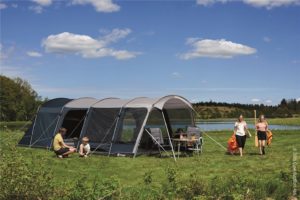
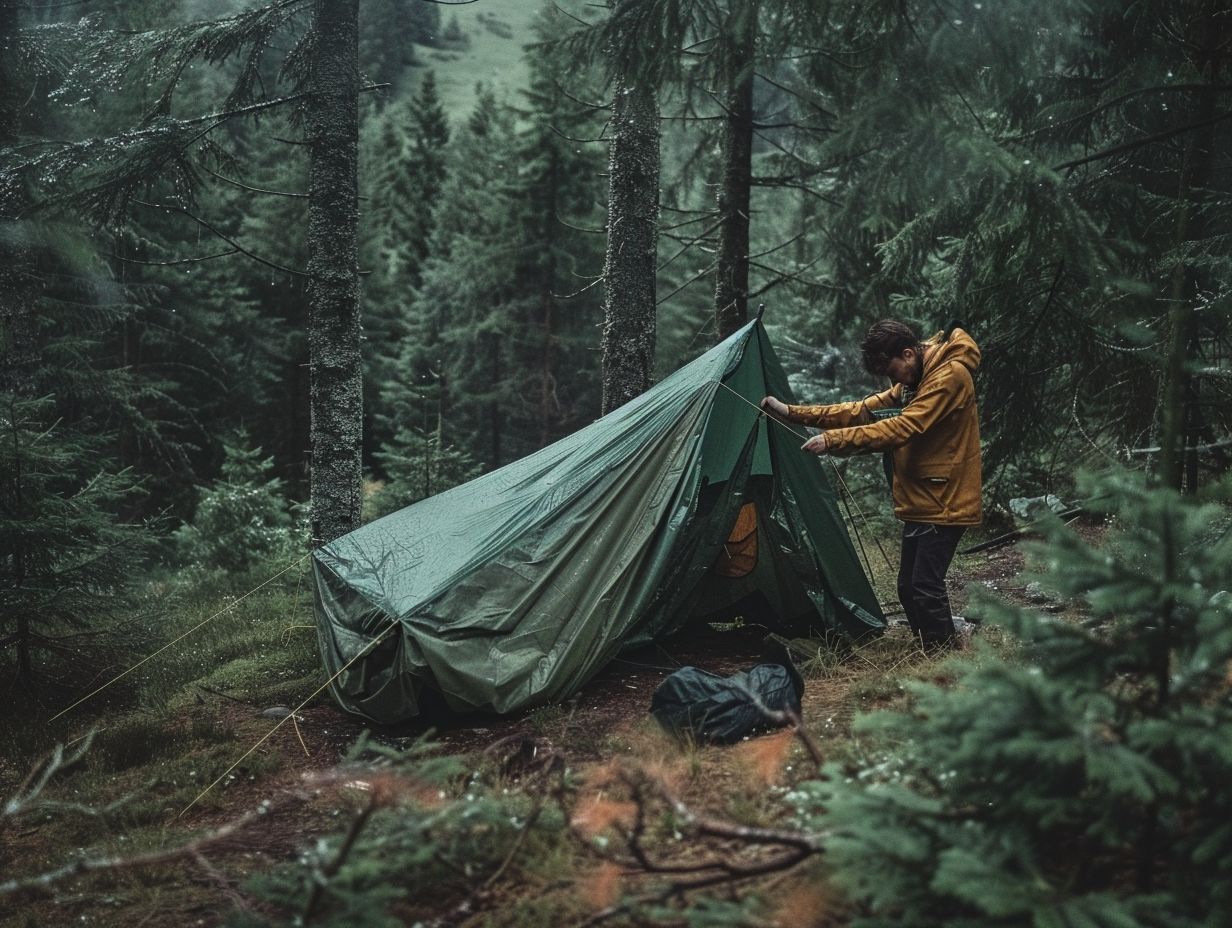
Vaibhav
- Categories: Advice
Are you looking to enhance your camping experience?
Camping with a tarp shelter may be the perfect solution for you! We explore the benefits of using a tarp shelter, including its lightweight and compact design, versatility, cost-effectiveness, and the unique connection it provides with nature.
We also discuss the different types of tarp shelters available, how to set one up, and provide some valuable tips for a successful camping trip with a tarp shelter.
Let’s get started!
Key Takeaways:

- Enjoy the lightweight and compact benefits of camping with a tarp shelter, making it easy to carry and set up.
- Experience the versatility and customisation options of different tarp shelter types, from A-frame to pyramid styles.
- Save money while getting a better connection with nature by choosing a tarp shelter for your camping adventure.
Why Should You Camp with a Tarp Shelter?
Tarp camping presents a highly versatile and lightweight shelter option for individuals who enjoy outdoor activities. It provides protection against a range of elements and can help improve one’s outdoor skills and connection to nature during expeditions in various climates and environments.
1. Lightweight and Compact
A tarp shelter is notably lightweight and compact, making it an optimal choice for hikers aiming to diminish their pack weight while still ensuring they carry essential gear.
The materials utilised in tarp shelters, specifically ripstop nylon, play a significant role in their reduced weight. Ripstop nylon is a robust and enduring fabric that contributes minimal weight to the overall shelter, enabling hikers to benefit from a sturdy shelter without the encumbrance of additional weight.
This weight-saving attribute is particularly advantageous for backpackers who prioritise efficiency and comfort during their outdoor expeditions.
Opting for a lightweight and compact tarp shelter grants hikers the ability to traverse long distances effortlessly and revel in the freedom to explore diverse terrains without the burden of heavy equipment.
2. Versatile and Customisable
Tarp shelters are renowned for their adaptability and versatility, offering campers the opportunity to tailor their configuration to different scenarios and enhance their outdoor proficiency through the mastery of various knots and arrangements.
By familiarising themselves with crucial knots such as the taut-line hitch and the bowline, campers can establish a secure tarp shelter in an A-frame format, ensuring superior protection against inclement weather conditions. The lean-to arrangement presents a swift and uncomplicated shelter alternative, particularly suitable for short breaks during hiking excursions.
Conversely, the pyramid style delivers a more resilient structure, affording generous space and stability in adverse weather environments. The ability to customise these configurations in accordance with the terrain and climatic conditions not only cultivates survival skills but also elevates the camping experience into a practical educational endeavour.
3. Cost-Effective
Tarp camping offers a significant advantage in terms of cost-effectiveness due to the generally lower price point of tarps in comparison to traditional tents. Despite their affordability, tarps are known for their durability and are often constructed from materials such as silicone-coated nylon.
The lightweight properties of tarp shelters facilitate easy transportation and setup, leading to savings in both time and energy. Moreover, the versatility of tarps enables users to configure them in various ways to accommodate differing weather conditions, thus providing a customisable camping experience without a substantial financial investment.
Outdoor enthusiasts can derive the benefits of tarp camping without compromising on quality, as these shelters deliver reliable protection against the elements while also promoting environmental sustainability in the long term.
4. Better Connection with Nature
Camping with a tarp shelter offers a unique opportunity for individuals to establish a profound connection with nature. This immersive experience allows campers to engage in an adventure that enhances their proximity to the natural elements, climate conditions, and terrain of their surroundings.
The absence of a conventional tent structure heightens the authenticity of the experience, enabling individuals to fully embrace the unfiltered essence of the natural environment.
The subtle whispers of the wind through the trees and the gentle patter of rain on the tarp above serve as sensory cues that foster a heightened sensitivity to fluctuations in weather patterns, temperature variations, and the auditory presence of wildlife in the vicinity.
This acute awareness cultivates a profound sense of unity with the surrounding ecosystem, fostering a deeper sense of reverence for the magnificence and inherent unpredictability of the natural world.
What Are the Different Types of Tarp Shelters?
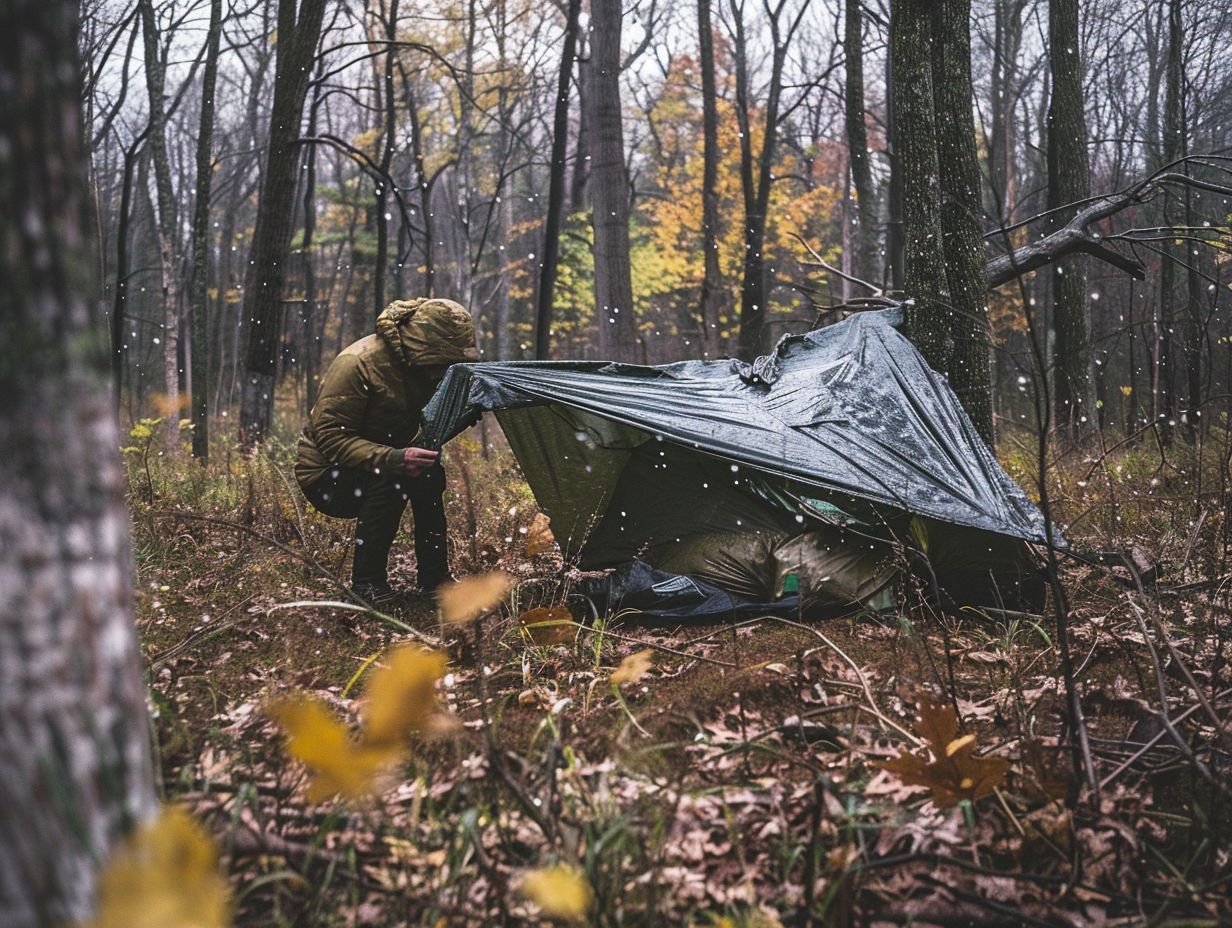
Various types of tarp shelters exist, each providing distinctive configurations and advantages tailored to diverse conditions, terrains, and climates, rendering them exceptionally versatile for a range of camping requirements.
1. A-Frame Tarp Shelter
The A-frame tarp shelter is considered a traditional and uncomplicated configuration that delivers exceptional protection against unfavourable weather conditions, all while necessitating fundamental knot-tying skills to secure the framework. The simplicity of the A-frame assembly process renders it an optimal choice for outdoor enthusiasts seeking a swift and dependable shelter solution.
To construct this shelter, one must be proficient in a selection of key knots, such as the bowline or the trucker’s hitch, both of which are relatively easy to master and afford substantial stability.
Whether encountering heavy rain, strong winds, or even snowfall, the A-frame design exhibits resilience against diverse weather patterns, providing a safe and dry environment to accommodate camping or survival requirements.
2. Lean-To Tarp Shelter
The lean-to tarp shelter configuration is considered optimal for locations characterised by prevailing winds and precipitation, as it features a sloped roof that effectively diverts water and serves as a windbreak.
The assembly of a lean-to tarp shelter entails affixing one end of the tarp overhead to a tree branch or a secure pole, with the opposing end being anchored close to the ground to ensure stability.
This design not only facilitates efficient rainwater runoff but also establishes a sheltered area shielded from turbulent winds, as the tarp functions as a protective barrier between occupants and the elements. The simplicity of its construction and adaptability to diverse terrains render it a favoured option for camping or hiking excursions that necessitate prompt and reliable shelter solutions.
3. Diamond Tarp Shelter
The diamond tarp shelter is a multipurpose structure that complements hammocks effectively, offering extensive coverage and adaptability to diverse camping environments.
Its assembly process is straightforward, beginning with the identification of two robust anchor points, typically trees, to secure two corners of the tarp. Subsequently, the tarp should be extended diagonally to form a diamond configuration, with adjustments made to the height and tension as required.
This shelter configuration provides shelter from adverse weather conditions such as rain and sunlight, rendering it well-suited for extended camping excursions. Its flexible nature permits customisation to align with specific settings, whether situated within a forest, along a shoreline, or amidst mountainous terrain.
4. Pyramid Tarp Shelter
The pyramid tarp shelter configuration is recognised for its durability and robust protection against severe weather conditions, attributed to its sturdy, pyramid-like structure. Setting up a pyramid tarp shelter entails anchoring the corners of the tarp securely to the ground to ensure a taut and stable fit.
This particular shape facilitates efficient shedding of rain and snow, thereby preventing water accumulation on the shelter’s surface. The steep angles inherent in the pyramid design enable snow and debris to slide off easily, reducing the likelihood of structural damage.
Moreover, the taut pitch of the shelter provides exceptional wind resistance, rendering it highly suitable for enduring storms and strong gusts. A pyramid tarp shelter serves as a dependable shelter solution for outdoor enthusiasts, whether camping in remote areas or encountering unpredictable weather conditions.
How to Set Up a Tarp Shelter?
The setting up of a tarpaulin shelter requires careful consideration regarding the site selection, acquisition of necessary materials, and skill in the execution of various knot-tying techniques to ensure a solid and effective shelter.
1. Choosing the Right Location
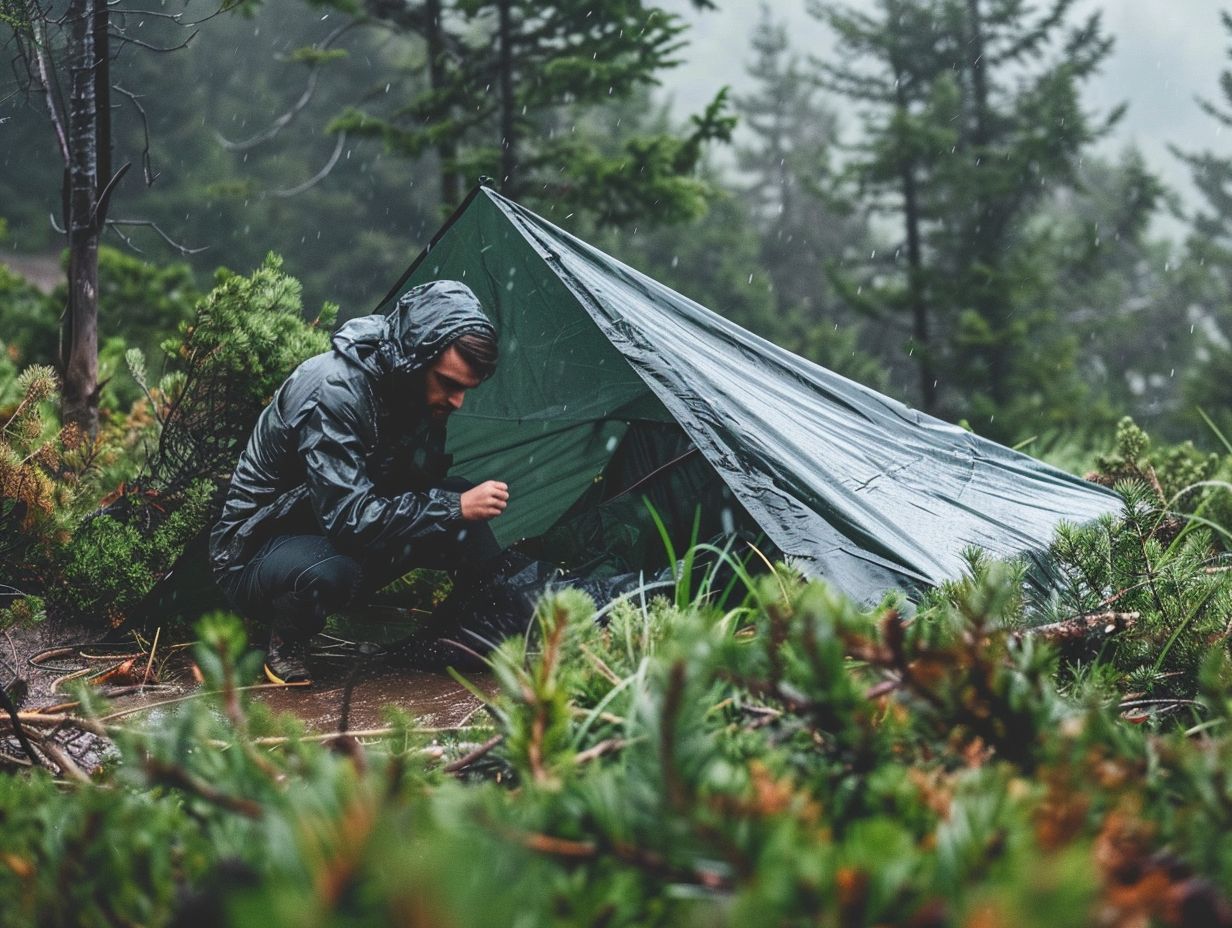
When selecting an appropriate location for a tarp shelter, it is essential to consider the terrain and climate to guarantee optimal protection and comfort throughout the camping excursion.
The terrain is critical in determining the stability and functionality of the tarp shelter. Identifying level ground that is devoid of rocks, roots, and sharp objects that could potentially puncture the tarp is imperative. It is advisable to refrain from establishing the shelter in low-lying areas that are susceptible to water accumulation during rainfall.
Moreover, the climate of the region holds equal significance. Placing the tarp shelter in a position that offers natural windbreaks, such as trees or bushes, can afford additional protection against wind gusts. By taking these aspects into contemplation, one can enhance the advantages provided by the tarp shelter, thereby ensuring a secure and comfortable camping experience.
2. Gathering Necessary Materials
The process of acquiring the necessary materials for constructing a tarp shelter involves the careful selection of durable equipment, such as high-quality tarps, ropes, and pegs, in order to establish a reliable and enduring shelter.
Plus the fundamental items, the inclusion of a sturdy set of poles or trekking poles can be highly advantageous for providing structural integrity and support to the tarp shelter. The presence of a mallet or hammer is essential for securely driving pegs into the ground, particularly in challenging terrains.
It is important to carry a knife or multitool for cutting ropes and facilitating swift adjustments. The acquisition of gear that can withstand diverse weather conditions and endure through multiple camping expeditions is essential to ensure a comfortable and secure outdoor excursion.
3. Setting Up the Tarp Shelter
The process of setting up the tarp shelter involves arranging the tarp in the desired configuration, securing it with appropriate knots, and ensuring it offers adequate protection from the elements. To begin, it is essential to select a suitable location for the tarp shelter that is flat and devoid of sharp objects that could potentially damage the tarp.
The tarp should be laid out on the ground with the preferred side facing outward. Stabilising the corners of the tarp with rocks or other heavy objects while working is recommended. For creating a pitched roof design, one corner of the tarp should be tied to a tree or pole at head height, while the opposite corner is pulled taut and secured to another point at ground level.
It is imperative to utilise robust knots like the bowline or taut-line hitch to ensure the shelter remains secure even in windy conditions.
What Are Some Tips for Camping with a Tarp Shelter?
Using a tarp shelter during camping can provide a rewarding experience. By following key guidelines, one can facilitate a successful installation, enhance outdoor proficiency, and ensure protection from adverse weather conditions.
1. Practice Setting Up Before Your Trip
It is essential to engage in the preparation of setting up a tarp shelter before embarking on any outdoor excursion in order to acquire the requisite outdoor skills and guarantee a seamless and effective camping experience.
Constructing a tarp shelter in a familiar setting, such as at home, offers the opportunity to acquaint oneself with the assembly process, identify and address any potential challenges, and make necessary adjustments. By refining one’s setup technique in a controlled environment, individuals can cultivate a sense of confidence and improve their problem-solving capabilities.
This hands-on experience further aids in comprehending the various configurations and attributes of the tarp, ensuring the ability to promptly adapt to changing weather conditions or terrain during outdoor activities. The investment of time in preparatory measures invariably contributes to a more gratifying and hassle-free camping venture.
2. Bring Extra Tarps and Bungee Cords
Including additional tarpaulins and elasticated cords in your supplies can offer enhanced protection and versatility, enabling the adjustment of your shelter arrangement according to varying weather conditions and ensuring comprehensive coverage.
The presence of additional tarpaulins allows for the easy expansion of the shelter’s dimensions or the creation of partitions for added privacy within the allocated space. Furthermore, elasticated cords provide a secure method of fastening the tarpaulins, thereby preventing any flapping in the wind or shifting during sudden weather changes.
By effectively utilising these resources, one can significantly bolster the durability and stability of the shelter, rendering it more resilient against harsh environmental elements like wind, rain, or snow.
3. Use Natural Elements for Support
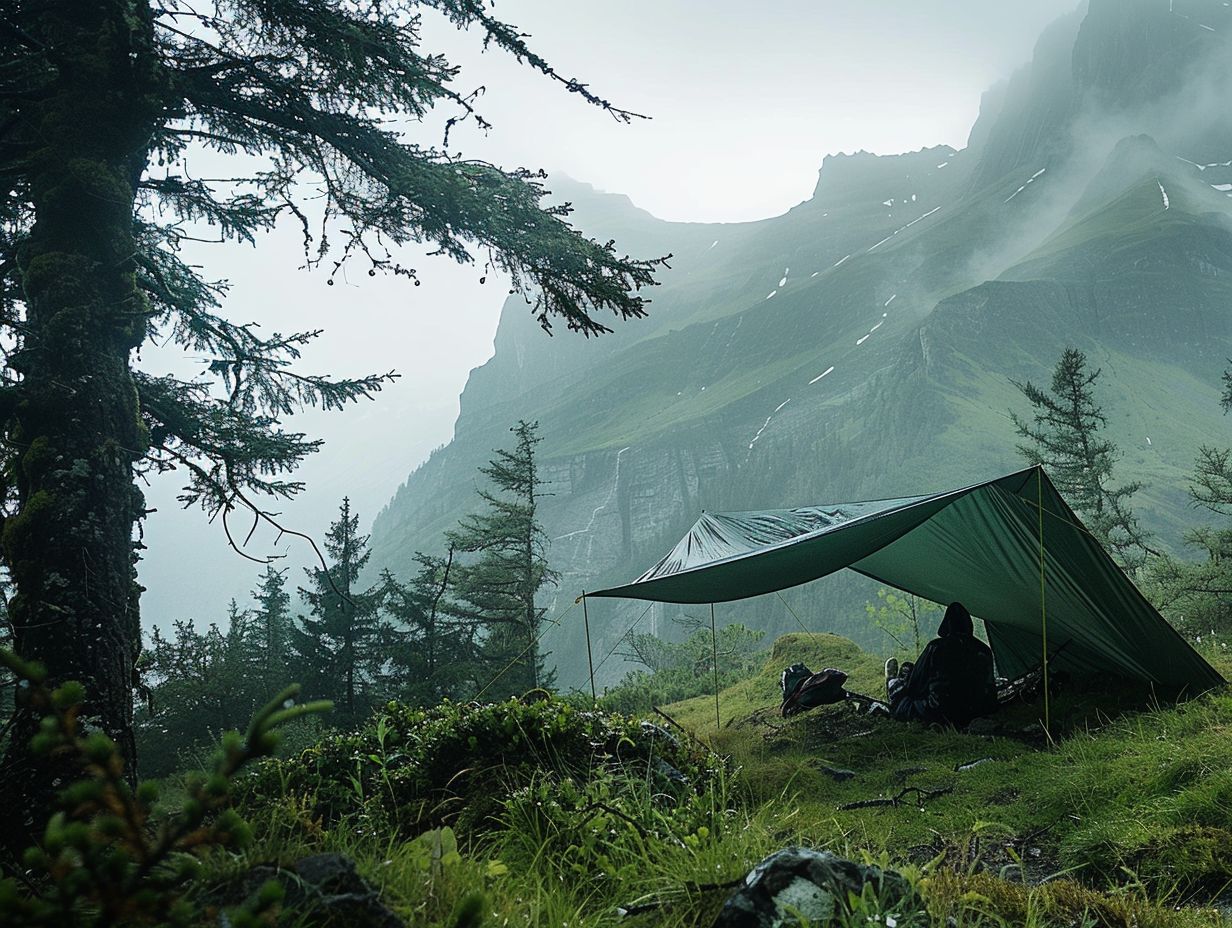
Utilising natural elements such as trees and rocks for support can enhance the stability and efficiency of a tarp shelter setup, optimising the utilisation of the surrounding environment. Tree branches can be strategically intertwined to provide additional support for the tarp shelter, resulting in a more resilient structure capable of withstanding various weather conditions.
By incorporating rocks as anchoring points, the corners of the tarp can be effectively secured, preventing shifting or collapse during strong winds.
This strategic use of natural elements not only reinforces the shelter’s structure but also integrates seamlessly with the landscape, reducing environmental impact and fostering a deeper connection with nature during outdoor excursions.
4. Make sure to secure the tarp properly.
It is imperative to ensure that the tarp is securely fastened using appropriate knots and correct tension to effectively shield against adverse weather conditions and uphold a stable shelter.
When fastening a tarp, it is essential to carefully choose the suitable knot based on the specific circumstances. For example, the versatile and dependable square knot is well-suited for joining two ropes or securing the corners of a tarp.
By regulating the tension through proper adjustment of the ropes, the tarp’s tautness is maintained. This is critical in preventing the formation of water puddles on the tarp’s surface and preventing wind from causing damage by lifting the tarp. Mastery of these techniques can prolong the durability of the tarp and enhance its ability to protect your possessions effectively.
Frequently Asked Questions
What is a tarp shelter and how does it differ from a traditional tent?
A tarp shelter is a lightweight, portable shelter made from a large piece of waterproof or water-resistant material. It differs from a traditional tent in that it does not have a designated floor or walls, and instead relies on trees or other anchor points for support.
What are the benefits of using a tarp shelter for camping?
There are several benefits to using a tarp shelter for camping. It is lighter and easier to pack than a traditional tent, it offers more versatility in terms of set-up and configuration, and it allows for a more immersive outdoor experience as you are not separated from nature by walls and a ceiling.
Can a tarp shelter withstand harsh weather conditions?
Yes, a tarp shelter can withstand harsh weather conditions if properly set up and anchored. The material used for tarps is typically waterproof or water-resistant, making it suitable for rain or snow. It is also possible to add additional layers or create a sturdier structure by using multiple tarps.
Are tarp shelters suitable for solo camping or only for groups?
Tarp shelters are suitable for both solo camping and group camping. They can be set up to accommodate one person or a larger group, depending on the size of the tarp and the configuration used. Additionally, they are a great option for solo campers who prefer a more minimalist and lightweight camping experience.
Do tarp shelters offer any advantages over traditional tents?
Yes, tarp shelters have several advantages over traditional tents. They are more affordable, easier to set up and take down, and can be used in a wider variety of terrains. They also offer better ventilation, as there are no walls or ceiling to trap heat and condensation.
Are there any specific tips for choosing the right tarp shelter for camping?
When choosing a tarp shelter for camping, consider the size and shape of the tarp, the material it is made of, and the type of terrain and weather conditions you will be camping in. It is also important to practice setting up the tarp before your camping trip to ensure you are comfortable and confident with the process.
Share:
By submitting your email address, you are agreeing to receive marketing emails from theexpertcamper.co.uk.
We’ll never share your email address and you can unsubscribe at any time. Privacy policy
Related Posts

A Seasonal Guide To Hiking In The Peak District
Are you ready to lace up your hiking boots and explore the stunning landscapes of the Peak District? This seasonal guide will take you through

Hiking Challenges Preparing For Your First Ultrahike
Are you ready to take your hiking adventures to the next level? Ultra-hiking offers a unique combination of physical and mental challenges, breathtaking scenery, and

Ecofriendly Hiking Tips For Sustainable Adventures
Are you an outdoor enthusiast looking to minimise your impact on the environment while enjoying the great outdoors? Eco-friendly hiking is the perfect solution! We

The Best Hiking Trails For Experiencing UK Wildlife
When exploring the picturesque hiking trails of the UK, you can expect to encounter a diverse array of wildlife. From majestic birds soaring overhead to

Wildflower Walks The Best Trails For Nature Lovers
Are you a nature lover looking to embark on a wildflower walk? Explore the best trails for wildflower walks, including [Trail Name 1], [Trail Name




